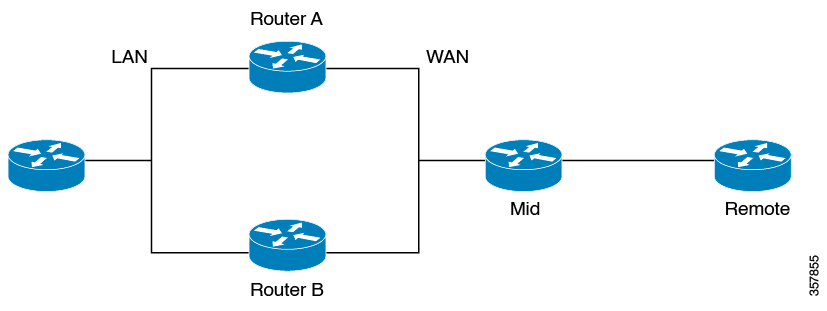Information About IPsec VPN High Availability Enhancements
Reverse Route Injection
Reverse Route Injection (RRI) simplifies network design for Virtual Private Networks (VPNs) in which there is a requirement for redundancy or load balancing. RRI works with both dynamic and static crypto maps.
RRI provides the following benefits:
-
Enables routing of IPsec traffic to a specific VPN headend device in environments that have multiple (redundant) VPN headend devices.
-
Ensures predictable failover time of remote sessions between headend devices when using IKE keepalives, especially in environments in which remote device route flapping is common (not taking into consideration the effects of route convergence, which may vary depending on the routing protocol used and the size of the network).
-
Eliminates the need for the administration of static routes on upstream devices, as routes are dynamically learned by these devices.
In the dynamic case, as remote peers establish IPsec security associations (SAs) with an RRI-enabled router, a static route is created for each subnet or host protected by that remote peer. For static crypto maps, a static route is created for each destination of an extended access list rule. When RRI is used on a static crypto map with an access control list (ACL), routes will always exist, even without the negotiation of IPsec SAs.
 Note |
The use of any keyword in ACLs with RRI is not supported. |
When routes are created, they are injected into any dynamic routing protocol and distributed to surrounding devices. This traffic flows, requiring IPsec to be directed to the appropriate RRI router for transport across the correct SAs to avoid IPsec policy mismatches and possible packet loss.
The figure below shows an RRI configuration functionality topology. Remote A is being serviced by Router A and Remote B connected to Router B, providing load balancing across VPN gateways at the central site. RRI on the central site devices ensures that the other router on the inside of the network can automatically make the correct forwarding decision. RRI also eliminates the need to administer static routes on the inside router.

Hot Standby Router Protocol and IPsec
Hot Standby Router Protocol (HSRP) provides high network availability by routing IP traffic from hosts on Ethernet networks without relying on the availability of any single router. HSRP is particularly useful for hosts that do not support a router discovery protocol, such as ICMP Router Discovery Protocol (IRDP) and do not have the functionality to switch to a new router when their selected router reloads or loses power. Without this functionality, a router that loses its default gateway because of a router failure cannot communicate with the network.
HSRP is configurable on LAN interfaces using standby command-line interface (CLI) commands. You can to use the standby IP address from an interface as the local IPsec identity or local tunnel endpoint.
By using the standby IP address as the tunnel endpoint, failover can be applied to VPN routers by using HSRP. Remote VPN gateways connect to the local VPN router via the standby address that belongs to the active device in the HSRP group. In the event of failover, the standby device takes over ownership of the standby IP address and begins to service remote VPN gateways.
Failover can be applied to VPN routers through the use of HSRP. Remote VPN gateways connect to the local VPN router through the standby address that belongs to the active device in the HSRP group. This functionality reduces configuration complexity on remote peers with respect to defining gateway lists, because only the HSRP standby address needs to be defined.
The figure below shows the enhanced HSRP functionality topology. Traffic is serviced by the active Router P, which is the active device in the standby group. In the event of failover, traffic is diverted to Router S, which is the original standby device. Router S assumes the role of the new active router and takes ownership of the standby IP address.

 Note |
In case of a failover, HSRP does not facilitate IPsec state information transference between VPN routers. This means that without this state transference, SAs to remotes will be deleted, requiring Internet Key Exchange (IKE) and IPsec SAs to be reestablished. To make IPsec failover more efficient, it is recommended that IKE keepalives be enabled on all routers. |

 Feedback
Feedback